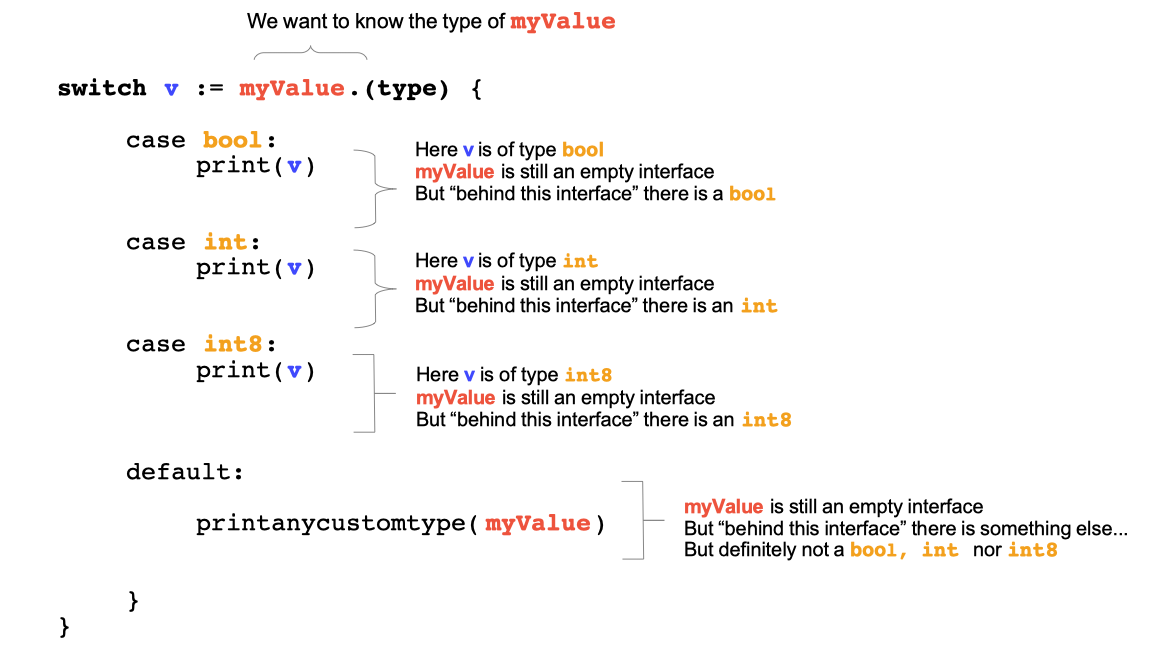
本篇翻译自《Practical Go Lessons》 Chapter 16: Interfaces
1 你将在本章学到什么?
- 什么是类型接口?
- 如何定义接口。
- “实现一个接口”是什么意思?
- 接口的优点
2 涵盖的技术概念
- 接口 interface
- 具体实现 concrete implementation
- 实现一个接口
- 接口的方法集
3 介绍
刚开始编程时,接口似乎很难理解。通常,新手程序员并不能完全理解接口的潜力。本节旨在解释什么是接口,它的有趣之处在哪里,以及如何创建接口。
4 接口的基本定义
- 接口是定义一组行为的契约
- 接口是一个纯粹的设计对象,它们只是定义了一组行为(即方法),而没有给出这些行为的任何实现。
- 接口是一种类型,它定义了一组方法而不实现它们
“实现” = “编写方法的代码”,这是一个示例接口类型(来自标准包 io):
type Reader interface {
Read(p []byte) (n int, err error)
}
这里我们有一个名为 Reader 的接口类型,它指定了一种名为 Read 的方法。该方法没有具体实现,唯一指定的是方法名称及其签名(参数类型和结果类型)。
4.0.0.1 接口类型的零值
接口类型的零值为 nil,例子:
var r io.Reader
log.Println(r)
// 2021/11/28 12:27:52 <nil>
5 基本示例
type Human struct {
Firstname string
Lastname string
Age int
Country string
}
type DomesticAnimal interface {
ReceiveAffection(from Human)
GiveAffection(to Human)
}
- 首先,我们声明一个名为
Human的类型 - 我们声明了一个名为
DomesticAnimal的新类型接口 - 这种类型的接口有一个由两个方法组成的方法集:
ReceiveAffection和GiveAffect。
DomesticAnimal 是一个契约。
- 它告诉开发者,要成为
DomesticAnimal,我们至少需要有两种行为:ReceiveAffection和GiveAffection
让我们创建两个类型:
type Cat struct {
Name string
}
type Dog struct {
Name string
}
我们有两种新类型。为了让他们遵守我们的接口 DomesticAnimal 的契约,
我们必须为每种类型定义接口指定的方法。
我们从 Cat 类型开始:
func (c Cat) ReceiveAffection(from Human) {
fmt.Printf("The cat named %s has received affection from Human named %s\n", c.Name, from.Firstname)
}
func (c Cat) GiveAffection(to Human) {
fmt.Printf("The cat named %s has given affection to Human named %s\n", c.Name, to.Firstname)
}
现在 Cat 类型实现了 DomesticAnimal 接口。我们现在对 Dog 类型做同样的事情:
func (d Dog) ReceiveAffection(from Human) {
fmt.Printf("The dog named %s has received affection from Human named %s\n", d.Name, from.Firstname)
}
func (d Dog) GiveAffection(to Human) {
fmt.Printf("The dog named %s has given affection to Human named %s\n", d.Name, to.Firstname)
}
我们的 Dog 类型现在正确地实现了 DomesticAnimal 接口。现在我们可以创建一个函数,它接受一个带有参数的接口:
func Pet(animal DomesticAnimal, human Human) {
animal.GiveAffection(human)
animal.ReceiveAffection(human)
}
Pet 函数将 DomesticAnimal 类型的接口作为第一个参数,将 Human 作为第二个参数。
在函数内部,我们调用了接口的两个函数。
让我们使用这个函数:
func main() {
// Create the Human
var john Human
john.Firstname = "John"
// Create a Cat
var c Cat
c.Name = "Maru"
// then a dog
var d Dog
d.Name = "Medor"
Pet(c, john)
Pet(d,john)
}
Dog和Cat类型实现了接口DomesticAnimal的方法- 也就是说
Dog和Cat类型的任何变量都可以看作是DomesticAnimal
只要
Cat实现的方法的函数签名与接口定义一致就可以,不强制要求完全相同变量名和返回名。所以我们将函数func (c Cat) ReceiveAffection(from Human) {...}改成func (c Cat) ReceiveAffection(f Human) {...}也是可以的
6 编译器在看着你!
遵守类型 T 的接口契约意味着实现接口的所有方法。让我们试着欺骗编译器看看会发生什么:
// ...
// let's create a concrete type Snake
type Snake struct {
Name string
}
// we do not implement the methods ReceiveAffection and GiveAffection intentionally
//...
func main(){
var snake Snake
snake.Name = "Joe"
Pet(snake, john)
}
- 我们创建了一个新类型的
Snake - 该类型没有实现
DomesticAnimal动物的任何方法 - 在主函数中,我们创建了一个新的
Snake类型的变量 - 然后我们用这个变量作为第一个参数调用
Pet函数
结果是编译失败:
./main.go:70:5: cannot use snake (type Snake) as type DomesticAnimal in argument to Pet:
Snake does not implement DomesticAnimal (missing GiveAffection method)
编译器在未实现的按字母顺序排列的第一个方法处检查停止。
7 例子:database/sql/driver.Driver
我们来看看 Driver 接口(来自包database/sql/driver)
type Driver interface {
Open(name string) (Conn, error)
}
- 存在不同种类的 SQL 数据库,因此
Open方法有多种实现。 - 为什么?因为你不会使用相同的代码来启动到 MySQL 数据库和 Oracle 数据库的连接。
- 通过构建接口,你可以定义一个可供多个实现使用的契约。
8 接口嵌入
你可以将接口嵌入到其他接口中。让我们举个例子:
// the Stringer type interface from the standard library
type Stringer interface {
String() string
}
// A homemade interface
type DomesticAnimal interface {
ReceiveAffection(from Human)
GiveAffection(to Human)
// embed the interface Stringer into the DomesticAnimal interface
Stringer
}
在上面的代码中,我们将接口 Stringer 嵌入到接口 DomesticAnimal 中。
因此,已经实现了 DomesticAnimal 的其他类型必须实现 Stringer 接口的方法。
- 通过接口嵌入,你可以在不重复的情况下向接口添加功能。
- 这也是有代价的,如果你从另一个模块嵌入一个接口,你的代码将与其耦合
- 其他模块接口的更改将迫使你重写代码。
- 请注意,如果依赖模块遵循语义版本控制方案,则这种危险会得到缓和
- 你可以毫无畏惧地使用标准库中的接口
9 来自标准库的一些有用(和著名)的接口
9.1 Error 接口
type error interface {
Error() string
}
这个接口类型被大量使用,用于当函数或方法执行失败是返会error类型接口:
func (c *Communicator) SendEmailAsynchronously(email *Email) error {
//...
}
要创建一个 error ,我们通常调用: fmt.Errorf() 返回一个 error 类型的结果,或者使用 errors.New()函数。
当然,你也可以创建实现error接口的类型。
9.2 fmt.Stringer 接口
type Stringer interface {
String() string
}
使用 Stringer 接口,你可以定义在调用打印方法时如何将类型打印为字符串(fmt.Errorf(),fmt.Println, fmt.Printf, fmt.Sprintf...)
这有一个示例实现
type Human struct {
Firstname string
Lastname string
Age int
Country string
}
func (h Human) String() string {
return fmt.Sprintf("human named %s %s of age %d living in %s",h.Firstname,h.Lastname,h.Age,h.Country)
}
Human 现在实现了 Stringer 接口:
package main
func main() {
var john Human
john.Firstname = "John"
john.Lastname = "Doe"
john.Country = "USA"
john.Age = 45
fmt.Println(john)
}
输出:
human named John Doe of age 45 living in the USA
9.3 sort.Interface 接口
type Interface interface {
Len() int
Less(i, j int) bool
Swap(i, j int)
}
通过在一个类型上实现 sort.Interface 接口,可以对一个类型的元素进行排序(通常,底层类型是一个切片)。
这是一个示例用法(来源:sort/example_interface_test.go):
type Person struct {
Age int
}
// ByAge implements sort.Interface for []Person based on
// the Age field.
type ByAge []Person
func (a ByAge) Len() int { return len(a) }
func (a ByAge) Swap(i, j int) { a[i], a[j] = a[j], a[i] }
func (a ByAge) Less(i, j int) bool { return a[i].Age < a[j].Age }
ByAge类型实现了sort.Interface- 底层类型是
Person的一个切片
- 底层类型是
- 接口由三个方法组成:
Len() int:返回集合内的元素数Less(i, j int) bool:如果索引i处的元素应该排在索引j处的元素之前,则返回trueSwap(i, j int):交换索引i&j处的元素;换句话说,我们应该将位于索引j的元素放在索引i处,而位于索引i的元素应该放在索引j处。
然后我们可以使用sort.Sort函数对ByAge类型的变量进行排序
func main() {
people := []Person{
{"Bob", 31},
{"John", 42},
{"Michael", 17},
{"Jenny", 26},
}
sort.Sort(ByAge(people))
}
10 隐式实现
接口是隐式实现的。当你声明一个类型时,你不必指定它实现了哪些接口。
11 PHP 和 JAVA
在其他语言中,你必须指定接口实现。
这是 Java 中的一个示例:
// JAVA
public class Cat implements DomesticAnimal{
public void receiveAffection(){
//...
}
public void giveAffection(){
//..
}
}
这是 PHP 中的另一个示例:
//PHP
<?php
class Cat implements DomesticAnimal {
public function receiveAffection():void {
// ...
}
public function giveAffection():void {
// ...
}
}
?>
你可以看到,在声明实现接口的类时,必须添加关键字"implements"。
你可能会问 Go 运行时如何处理这些隐式接口实现。我们将后面解释接口值的机制。
12 空接口
Go 的空接口是你可以编写的最简单、体积更小的接口。它的方法集正好由 0 个方法组成。
interface{}
也就是说,每种类型都实现了空接口。你可能会问为什么需要这么无聊的空接口。根据定义,空接口值可以保存任何类型的值。如果你想构建一个接受任何类型的方法,它会很有用。
让我们从标准库中举一些例子。
- 在
log包中,你有一个Fatal方法,可以将任何类型的输入变量作为输入:
func (l *Logger) Fatal(v ...interface{}) { }
- 在
fmt包中,我们还有许多方法将空接口作为输入。例如Printf函数:
func Printf(format string, a ...interface{}) (n int, err error) { }
12.1 类型转换
接受空接口作为参数的函数通常需要知道其输入参数的有效类型。
为此,该函数可以使用“类型开关”,这是一个 switch case 将比较类型而不是值。
这是从标准库(文件 runtime/error.go,包 runtime)中获取的示例:
// printany prints an argument passed to panic.
// If panic is called with a value that has a String or Error method,
// it has already been converted into a string by preprintpanics.
func printany(i interface{}) {
switch v := i.(type) {
case nil:
print("nil")
case bool:
print(v)
case int:
print(v)
case int8:
print(v)
case int16:
print(v)
case int32:
print(v)
case int64:
print(v)
case uint:
print(v)
case uint8:
print(v)
case uint16:
print(v)
case uint32:
print(v)
case uint64:
print(v)
case uintptr:
print(v)
case float32:
print(v)
case float64:
print(v)
case complex64:
print(v)
case complex128:
print(v)
case string:
print(v)
default:
printanycustomtype(i)
}
}

12.2 关于空接口的使用
- 你应该非常小心地使用空接口。
- 当你别无选择时,请使用空接口。
- 空接口不会向将使用你的函数或方法的人提供任何信息,因此他们将不得不参考文档,这可能会令人沮丧。
你更喜欢哪种方法?
func (c Cart) ApplyCoupon(coupon Coupon) error {
//...
}
func (c Cart) ApplyCoupon2(coupon interface{}) (interface{},interface{}) {
//...
}
ApplyCoupon 方法严格指定它将接受和返回的类型。而 ApplyCoupon2 没有在输入和输出中指定它的类型。作为调用方,ApplyCoupon2 的使用难度比 ApplyCoupon 大。
13 实际应用:购物车存储
13.1 规则说明
你建立了一个电子商务网站;你必须存储和检索客户购物车。必须支持以下两种行为:
- 通过 ID 获取购物车
- 将购物车数据放入数据库
为这两种行为提出一个接口。还要创建一个实现这两个接口的类型(不要实现方法中的逻辑)。
13.2 答案
这是一个设计的接口:
type CartStore interface {
GetById(ID string) (*cart.Cart, error)
Put(cart *cart.Cart) (*cart.Cart, error)
}
实现接口的类型:
type CartStoreMySQL struct{}
func (c *CartStoreMySQL) GetById(ID string) (*cart.Cart, error) {
// implement me
}
func (c *CartStoreMySQL) Put(cart *cart.Cart) (*cart.Cart, error) {
// implement me
}
另一种实现接口的类型:
type CartStorePostgres struct{}
func (c *CartStorePostgres) GetById(ID string) (*cart.Cart, error) {
// implement me
}
func (c *CartStorePostgres) Put(cart *cart.Cart) (*cart.Cart, error) {
// implement me
}
- 你可以为你使用的每个数据库模型创建一个特定的实现
- 添加对新数据库引擎的支持很容易!你只需要创建一个实现接口的新类型。
14 为什么要使用接口?
14.1 易于升级
当你在方法或函数中使用接口作为输入时,你将程序设计为易于升级的。未来的开发人员(或未来的你)可以在不更改大部分代码的情况下创建新的实现。
假设你构建了一个执行数据库读取、插入和更新的应用程序。你可以使用两种设计方法:
- 创建与你现在使用的数据库引擎密切相关的类型和方法。
- 创建一个接口,列出数据库引擎的所有操作和具体实现。
- 在第一种方法中,你创建将特定实现作为参数的方法。
- 通过这样做,你将程序限制到一个实现。
- 在第二种方法中,你创建接受接口的方法。
- 改变实现就像创建一个实现接口的新类型一样简单。
14.2 提高团队合作
团队也可以从接口中受益。
在构建功能时,通常需要多个开发人员来完成这项工作。如果工作需要两个团队编写的代码进行交互,他们可以就一个或多个接口达成一致。
然后,两组开发人员可以处理他们的代码并使用商定的接口。他们甚至可以 mock 其他团队的返回结果。通过这样做,团队不会被阻塞。
14.3 Benefit from a set of routines
在自定义类型上实现接口时,你可以不需要开发就使用的附加功能。让我们从标准库中举一个例子:sort 包。这并不奇怪。这个包是用来进行排序的。这是 go 源代码的摘录:
// go v.1.10.1
package sort
//..
type Interface interface {
// Len is the number of elements in the collection.
Len() int
// Less reports whether the element with
// index i should sort before the element with index j.
Less(i, j int) bool
// Swap swaps the elements with indexes i and j.
Swap(i, j int)
}
// Sort sorts data.
// It makes one call to data.Len to determine n, and O(n*log(n)) calls to
// data.Less and data.Swap. The sort is not guaranteed to be stable.
func Sort(data Interface) {
n := data.Len()
quickSort(data, 0, n, maxDepth(n))
}
在第一行,我们声明当前包:sort。在接下来的几行中,程序员声明了一个名为 Interface 的接口。这个接口 Interface 指定了三个方法:Len、Less、Swap。
在接下来的几行中,函数 Sort 被声明。它将接口类型 data 作为参数。这是一个非常有用的函数,可以对给定的数据进行排序。
我们如何在我们的一种类型上使用这个函数?实现接口
假设你有一个 User 类型:
type User struct {
firstname string
lastname string
totalTurnover float64
}
还有一个类型 Users ,它是 User 类型切片:
type Users []User
让我们创建一个 Users 实例并用三个 User 类型的变量填充它:
user0 := User{firstname:"John", lastname:"Doe", totalTurnover:1000}
user1 := User{firstname:"Dany", lastname:"Boyu", totalTurnover:20000}
user2 := User{firstname:"Elisa", lastname:"Smith Brown", totalTurnover:70}
users := make([]Users,3)
users[0] = user0
users[1] = user1
users[2] = user2
如果我们想按营业额排序怎么办?我们可以从头开始开发符合我们规范的排序算法。或者我们可以只实现使用 sort 包中的内置函数.Sort 所需的接口。我们开始吧:
// Compute the length of the array. Easy...
func (users Users) Len() int {
return len(users)
}
// decide which instance is bigger than the other one
func (users Users) Less(i, j int) bool {
return users[i].totalTurnover < users[j].totalTurnover
}
// swap two elements of the array
func (users Users) Swap(i, j int) {
users[i], users[j] = users[j], users[i]
}
通过声明这些函数,我们可以简单地使用 Sort 函数:
sort.Sort(users)
fmt.Println(users)
// will output :
[{Elisa Smith Brown 70} {John Doe 1000} {Dany Boyu 20000}]
15 一点建议
- 尽量使用标准库提供的接口
- 方法太多的接口很难实现(因为它需要编写很多方法)。
16 随堂测试
16.1 问题
- 举一个接口嵌入另一个接口的例子。
- 判断真假。嵌入接口中指定的方法不是接口方法集的一部分。
- 说出使用接口的两个优点。
- 接口类型的零值是多少?
16.2 答案
- 举一个接口嵌入另一个接口的例子。
type ReadWriter interface {
Reader
Writer
}
- 判断真假。嵌入接口中指定的方法不是接口方法集的一部分。
错。接口的方法集是由两个部分组成:- 直接指定到接口中的方法
- 来自嵌入接口的方法
- 说出使用接口的两个优点。
- 轻松地在开发人员之间拆分工作:
1.定义接口类型
2.一个人开发接口的实现
3.另一个人可以在其功能中使用接口类型
4.两个人可以互不干扰地工作。 - 易于升级
1.当你创建一个接口时,你就创建了一个契约
2.不同的实现可以履行这个契约。
3.在一个项目的开始,通常有一个实现
4.随着时间的推移,可能需要另一种实现方式。
- 轻松地在开发人员之间拆分工作:
- 接口类型的零值是多少?
nil
17 关键要点
- 接口就是契约
- 它指定方法(行为)而不实现它们。
type Cart interface {
GetById(ID string) (*cart.Cart, error)
Put(cart *cart.Cart) (*cart.Cart, error)
}
- 接口是一种类型(就像structs, arrays, maps,等)
- 我们将接口中指定的方法称为接口的方法集。
- 一个类型可以实现多个接口。
- 无需明确类型实现了哪个接口
- 与其他需要声明它的语言(PHP、Java 等)相反
- 一个接口可能嵌入到另一个接口中;在这种情况下,嵌入的接口方法被添加到接口中。
- 接口类型可以像任何其他类型一样使用
- 接口类型的零值为
nil。 - 任何类型实现空接口
interface{} - 空接口指定了 0 个方法
- 要获取空接口的具体类型,您可以使用 type switch:
switch v := i.(type) {
case nil:
print("nil")
case bool:
print(v)
case int:
print(v)
}
- 当我们可以通过各种方式实现一个行为时,我们或许可以创建一个接口。
- 例如:存储(我们可以使用 MySQL、Postgres、DynamoDB、Redis 数据库来存储相同的数据)